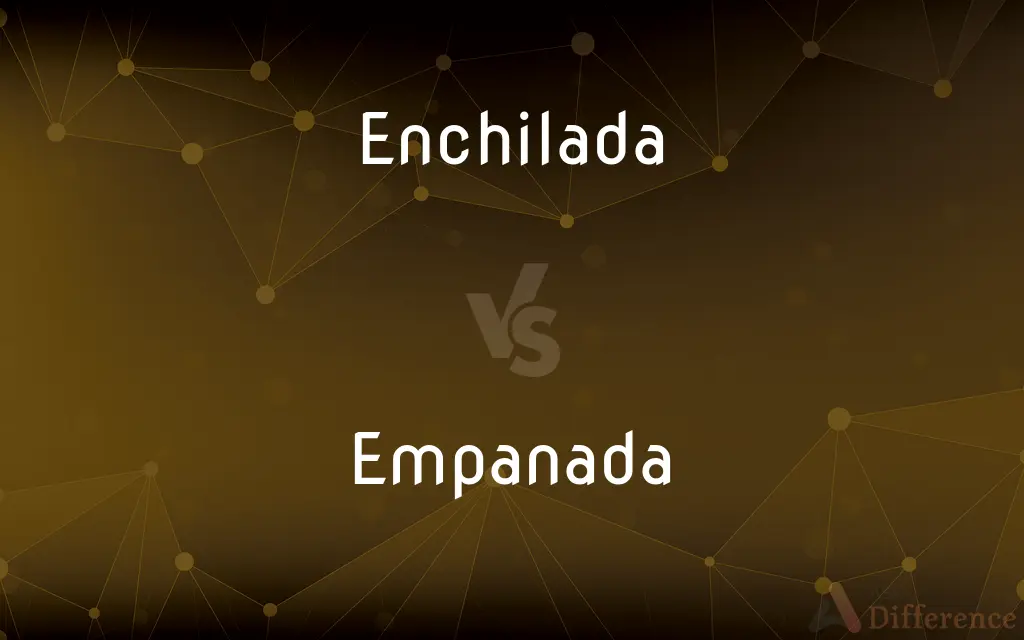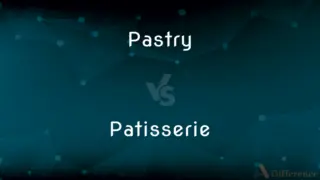Enchilada vs. Empanada — What's the Difference?
By Tayyaba Rehman — Updated on November 6, 2023
Enchiladas are Mexican dishes featuring corn tortillas rolled around various fillings and smothered in chili sauce, while empanadas are stuffed pastries, either baked or fried, popular across Latin America.

Difference Between Enchilada and Empanada
Table of Contents
ADVERTISEMENT
Key Differences
Enchilada and Empanada are both staples in Latin American cuisines but hail from different origins and culinary traditions. An enchilada is a traditional Mexican dish where a corn tortilla is rolled around a filling, which typically includes meat, cheese, beans, potatoes, vegetables, or combinations thereof, and then covered in a chili pepper sauce. In contrast, an empanada is a type of baked or fried turnover consisting of pastry and filling, common in Southern European, Latin American, and Filipino cuisines. The fillings for empanadas can also be diverse, ranging from meat, cheese, vegetables, to fruits, and more.
While enchiladas are always served warm, typically smothered with a sauce, empanadas can be found served either hot or cold, without a sauce, making them a more portable food option. An enchilada's sauce is a critical component, made from various chili peppers, which infuses the dish with its distinctive flavor and heat. On the other hand, the dough of an empanada can be wheat or corn-based and is often flavored, but the dish’s unique taste largely depends on the filling rather than the exterior.
When considering their preparation, enchiladas require the tortillas to be briefly fried before being filled and rolled, ensuring they are pliable and able to absorb the sauce. Empanadas, conversely, are about the interplay between the crust and its filling, with the dough being carefully sealed around the edges to contain the filling during baking or frying. This difference in preparation highlights the contrast in texture between the two dishes; enchiladas tend to have a softer, more sauce-saturated texture, while empanadas are prized for their crisp, flaky crust.
In terms of presentation, enchiladas are typically served on a plate, often with a side of rice and beans, and are eaten with utensils. Empanadas, being self-contained with a sturdy outer crust, are often considered a finger food, perfect for eating on the go without the need for additional cutlery or dishes. This distinction makes enchiladas more of a sit-down meal, while empanadas are versatile enough to be a snack, appetizer, or part of a larger meal.
Despite these differences, both enchiladas and empanadas are beloved for their flavorful combinations and the comfort food satisfaction they provide. Each has a wide variety of regional variations and personal interpretations, reflecting the rich culinary heritages from which they come. They are both celebrated dishes that have crossed their original borders to gain international fame, becoming part of the global culinary landscape.
ADVERTISEMENT
Comparison Chart
Origin
Mexican
Latin American, Southern European, Filipino
Base Ingredient
Corn tortilla
Pastry dough
Cooking Method
Baked with sauce
Baked or fried
Temperature Served
Warm
Hot or cold
Typical Consumption
Eaten with utensils
Finger food
Texture
Soft and sauce-saturated
Crisp and flaky
Portability
Less portable, sit-down dish
Highly portable, snack or meal
Serving Size
Typically individual portions
Individual or shared portions
Customization
Filling and sauce types
Filling varieties
Regional Variations
Various across Mexico
Diverse across many countries
Compare with Definitions
Enchilada
A rolled tortilla with a filling, baked in chili sauce.
For dinner, I made chicken enchiladas topped with a spicy verde sauce.
Empanada
A stuffed pastry that can be either baked or fried.
I bought a beef empanada from the food truck on the corner.
Enchilada
Often accompanied by rice and beans in Mexican meals.
Our meal came with two enchiladas, a side of rice, and refried beans.
Empanada
Popular in Latin American, Southern European, and Filipino cuisines.
For our international dinner night, we're making empanadas as the appetizer.
Enchilada
Can be stuffed with a variety of ingredients.
The vegetarian enchiladas were stuffed with roasted vegetables and topped with queso fresco.
Empanada
Contains fillings such as meat, cheese, or vegetables.
The spinach and cheese empanada is my favorite lunchtime snack.
Enchilada
A savory Mexican dish featuring a corn wrap.
Each enchilada was filled with cheese and onions, a simple yet delicious combination.
Empanada
Can be sweet or savory, depending on the filling.
After dinner, we enjoyed a sweet apple empanada with ice cream.
Enchilada
A traditional cuisine item garnished with cheese or sour cream.
She garnished the enchiladas with a dollop of sour cream and some fresh cilantro.
Empanada
Often eaten as a finger food or appetizer.
At the party, everyone loved the mini chicken empanadas that were served.
Enchilada
An enchilada (, Spanish: [entʃiˈlaða]) is a corn tortilla rolled around a filling and covered with a savory sauce. Originally from Mexican cuisine, enchiladas can be filled with various ingredients, including meats, cheese, beans, potatoes, vegetables, or combinations.
Empanada
An empanada is a type of baked or fried turnover consisting of pastry and filling, common in Southern European, Latin American, and the Philippines cultures. The name comes from the Galician verb empanar, and translates as "enbreaded", that is, wrapped or coated in bread.
Enchilada
A tortilla rolled and stuffed usually with a mixture containing meat or cheese and served with a sauce spiced with chili.
Empanada
A Spanish or Latin American turnover with a flaky crust and a savory or sweet filling.
Enchilada
A Mexican dish made by wrapping a filling in a tortilla, then baking in a sauce.
Empanada
Any of a variety of stuffed pastries found in Spanish, Filipino, and Latin American cuisine.
Enchilada
Tortilla with meat filling baked in chili-seasoned tomato sauce
Common Curiosities
What is an enchilada?
An enchilada is a Mexican dish consisting of a corn tortilla rolled around a filling and covered with chili sauce.
Are enchiladas spicy?
Enchiladas can be spicy depending on the type of chili sauce used, but there are also milder versions available.
Can enchiladas be made vegetarian?
Yes, enchiladas can be made vegetarian with fillings like beans, cheese, and vegetables.
What is the dough for empanadas made of?
Empanada dough is typically made from wheat or corn flour and can be either flaky or more bread-like in texture.
How are empanadas cooked?
Empanadas can be baked or fried until golden brown.
Can you eat empanadas on the go?
Yes, empanadas are portable and can be eaten without utensils, making them a popular street food.
How is an enchilada served?
Enchiladas are baked and served warm, typically smothered in chili sauce and sometimes garnished with cheese, sour cream, or cilantro.
What ingredients are in an enchilada?
Enchiladas can contain ingredients like meat, cheese, beans, potatoes, vegetables, or combinations, all rolled in a corn tortilla.
Do empanadas have sauce inside?
Unlike enchiladas, empanadas do not typically have sauce inside but may be served with a dipping sauce on the side.
Are empanadas only savory?
No, empanadas can be savory or sweet, depending on the filling.
Is there a difference in regional empanada styles?
Yes, empanada fillings and styles can vary widely across different regions and countries.
What is an empanada?
An empanada is a type of baked or fried turnover filled with meats, cheeses, vegetables, or fruits, and is common in many cultures.
Are empanadas gluten-free?
Empanadas are not typically gluten-free due to the flour in the dough, but gluten-free versions can be made using alternative flours.
Are enchiladas considered a full meal?
Enchiladas are often served as a main course, typically accompanied by sides like rice and beans.
Can enchiladas be frozen?
Yes, enchiladas can be assembled and frozen for later baking.
Share Your Discovery

Previous Comparison
Maize vs. Millet
Next Comparison
Pastry vs. PatisserieAuthor Spotlight
Written by
Tayyaba RehmanTayyaba Rehman is a distinguished writer, currently serving as a primary contributor to askdifference.com. As a researcher in semantics and etymology, Tayyaba's passion for the complexity of languages and their distinctions has found a perfect home on the platform. Tayyaba delves into the intricacies of language, distinguishing between commonly confused words and phrases, thereby providing clarity for readers worldwide.
















































